
Untitled [view of the imperial palace] Nguyễn Nam Sơn from a painting by Henri Dabadie, L’Annam, la Xe foire de Hanoi (1929).
The case of Huế is particularly interesting for me because the city’s image is intrinsically associated with the arts and handicrafts. Since becoming the capital of the Nguyễn dynasty in 1802, the imperial city held Đại Nam’s most refined and luxurious objects, whether imported or produced by the imperial workshops. After the colonial period, in the 1960s, Huế was famous for its very active artistic circles. Today, the image of Huế as an artistic city is still carefully cultivated. The Huế Festival for instance was conceived originally in 2000 as an event to promote contemporary art and the heritage of ancient artistic practices. During the colonial period, however, the city’s image and its artistic dimension were frozen in time; the city was presented as a reliquary rather than as a living center of artistic production. It is this hiatus that I wish to study.
Huế’s art was underrepresented in the Indochinese sections of the Universal and Colonial Exhibitions. Huế’s handicrafts were hardly mentioned in tourist guides of the time, contrary to the craft-making in Hanoi, which became a major tourist attraction. The artistic centers of production had been relocated to the French capital of Indochina and the colony of Cochinchina with the creation of the artistic schools of Biên Hòa, Thủ Dầu Một, and Gia Định. While in the eyes of many French, Huế was still the place where refined “Annamite” art could be found, this admiration was more about museification than anything else. All art in Huế was seen as oriented toward the past. Contrary to what the French did in Cambodia, where they put all their efforts into “reviving” past artistic traditions, it seems that French conquest resulted in the “death” of artistic practices in Huế.
Graphic arts provides a useful channel to explore this apparent contradiction. In the light of my initial findings, I am dividing images into two categories. In one category, I put landscapes or picturesque scenes, with an emphasis on the imperial palace by French and Vietnamese academic artists who received a Beaux-Arts training. In the other category, I put various productions in documents related to the imperial court. In this category I include works such as those of the literati Nguyễn Văn Nhân. I also include illustrations for literature such as those in the recently rediscovered version of Lục Vân Tiên, which was illustrated by the government official Lê Đức Trạch. Finally, I include ornamental prints made by craftsmen. Although different in form and purpose, all of these images were directly related to literati culture. During my first year of research, I will collect data from these two categories to create a corpus to study.

Cover of L’Annam ses provinces, ses ressources (1925). All the illustrations of the book use prints collected in Huế by the Amis du Vieux Hue.

